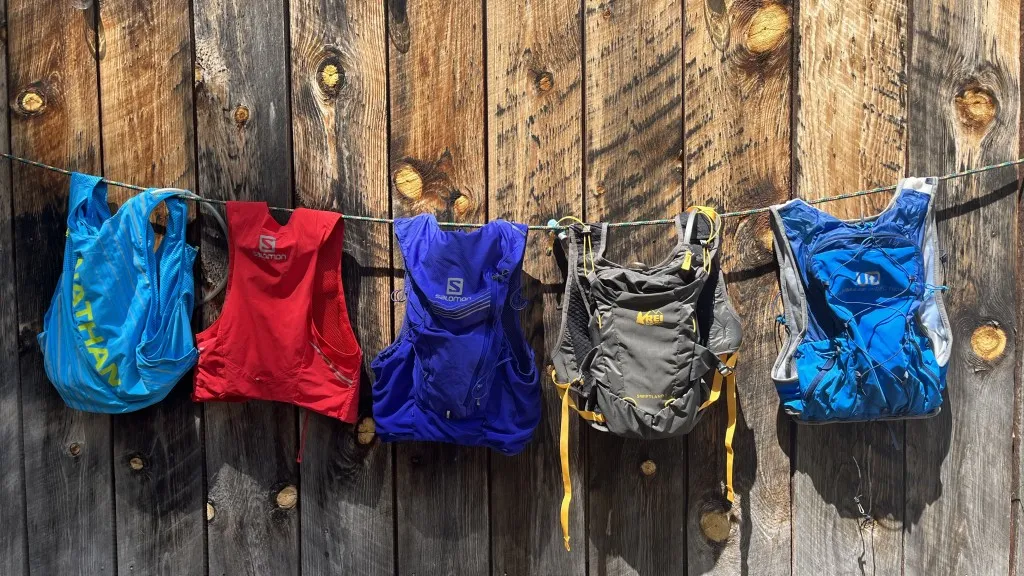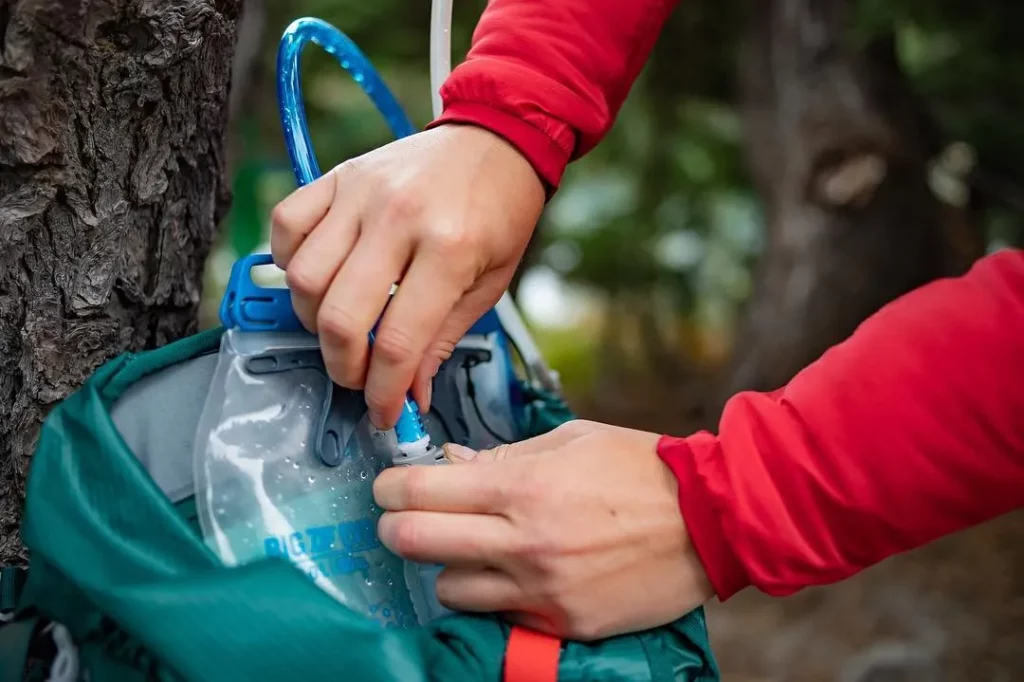Expert Guide: How to Use a Water Backpack Effectively

Welcome to my comprehensive guide on how to use a water backpack effectively. Whether you’re a hiker, runner, or cyclist, having access to water is crucial for optimal performance and safety. A water backpack, also known as a hydration pack, is an excellent option for carrying water hands-free during your adventures.
In this guide, I’ll take you through everything you need to know about using a water backpack effectively. From selecting the right backpack to filling it up, adjusting it for comfort, and maintaining hydration throughout your adventure, I’ve got you covered.
Key Takeaways:
- Learn how to choose the right water backpack for your needs
- Discover essential techniques for preparing and filling your backpack
- Find out how to maintain proper hydration during your adventures
- Get tips on caring for and troubleshooting common issues with your water backpack
- Explore advanced techniques to enhance your water backpack usage
Why Choose a Water Backpack?
As outdoor enthusiasts, we all know the importance of staying hydrated during our adventures. However, carrying a water bottle in your hand or lugging around a heavy hydration system can be inconvenient and uncomfortable. This is where a water backpack comes in handy.
A water backpack, also known as a hydration backpack, is a specially designed backpack with a built-in water reservoir and drinking tube. It allows you to carry a large amount of water comfortably on your back, making it easy to stay hydrated without interrupting your activity.
Water Backpack Uses

A water backpack is not just limited to outdoor activities like hiking, biking, or camping. It can also be used for various other activities where staying hydrated is essential, such as:
- Running and jogging
- Outdoor sports like soccer, basketball, or tennis
- Traveling to remote areas without easy access to water
A water backpack can help you stay hydrated during any activity that requires physical exertion and sweating.
Maximizing the Use of a Water Backpack
To make the most of your water backpack, consider the following tips:
- Choose the right backpack size and style for your activity. A larger backpack may be necessary for longer activities or when you need to carry more gear.
- Take the time to fit and adjust the backpack properly to your body. This will ensure a comfortable and stable fit while on the move.
- Regularly clean and maintain your water backpack to ensure its longevity and optimal performance.
A water backpack is an investment in your health and comfort during outdoor activities. By maximizing its use and taking care of it properly, you can stay hydrated and focused on enjoying your adventure.
Selecting the Right Water Backpack
Choosing the right water backpack is essential for a comfortable and enjoyable experience. Here are some tips to consider when selecting your water backpack:
- Capacity: Choose a backpack with a capacity that meets your needs. Consider the length of your adventure, climate conditions, and your water needs in relation to your activity level.
- Size and Fit: Ensure your backpack fits comfortably and is the right size for your body type. Look for adjustable straps, sternum straps, and hip belts to ensure a secure fit and optimal weight distribution. A poorly fitting backpack can cause discomfort and even injury over time.
- Hydration System: Consider your preferred hydration system. Some backpacks have built-in systems, while others accommodate hydration bladders or water bottles. Think about how you prefer to drink water during your activity.
- Features: Look for additional features that suit your needs and preferences. Some popular features include pockets for storing snacks or gear, compression straps for securing the load, and reflective accents for visibility.
With these tips in mind, you’ll be able to find a backpack that meets your needs. Remember to try on multiple options and test the fit before making a final decision. Now that you’ve selected your backpack, it’s time to move on to preparing it for use.
Preparing Your Water Backpack

Before embarking on your adventure, it’s crucial to prepare your water backpack properly. This not only ensures that your backpack is clean and free of contaminants but also guarantees that it’s filled to the brim and ready to be used.
Here are some essential water backpack preparation tips to keep in mind:
- Clean your backpack thoroughly using warm water and soap. Make sure to rinse the backpack thoroughly and let it air dry completely before filling it with water.
- Inspect the backpack for any signs of wear and tear, such as holes or frayed straps, and make repairs or replacements as necessary.
- Check that all the components of the backpack are properly attached and in good working condition, including the reservoir, drinking tube, and valve.
- Fill the reservoir with clean drinking water. You can also add flavoring or electrolyte tablets to enhance the taste and replenish lost nutrients during your adventure.
- Before sealing the backpack, make sure to remove all the air bubbles from the reservoir by squeezing it gently. This ensures proper water flow and prevents any leaks.
Following these simple steps can ensure that your water backpack is in top condition and ready to keep you properly hydrated throughout your adventure. Remember to bring extra water bottles or purification tablets in case of emergencies.
Filling and Adjusting Your Water Backpack
Now that you have your water backpack prepared, it’s time to fill it up and adjust it to fit comfortably on your back. Here’s how:
Filling Your Water Backpack

The first step is to fill the water reservoir in your backpack with clean, potable water. Follow these steps:
- Remove the reservoir from the backpack and unscrew the cap.
- Fill the reservoir with water. If the reservoir has a fill line, make sure you do not exceed it.
- Make sure the cap is securely tightened to prevent leaks.
- Insert the reservoir back into the backpack, making sure it is properly seated, and all hoses are connected.
Pro Tip: If you are unsure about the quality of water in the area you are visiting, it’s always best to bring your water or use a filter.
Adjusting Your Water Backpack
Once your water backpack is filled, it’s important to make sure it fits properly to ensure optimal weight distribution and stability. Follow these steps:
- Please put on your backpack and adjust the shoulder straps so they sit comfortably on your shoulders. They should be snug but not too tight, and the backpack should not bounce or shift as you move.
- Adjust the sternum strap to your desired tightness if your backpack has one. This can help stabilize the backpack and prevent it from bouncing.
- Adjust the waist belt if your backpack has one. This is important to shift the weight of the backpack to your hips instead of your shoulders, making it easier to carry for long periods.
- Make sure the backpack is centered on your back, and adjust the load-lifter straps if your backpack has them. These straps connect the top of the shoulder straps to the top of the backpack, helping to transfer weight to your hips and improve balance.
Pro Tip: Adjust your backpack while it’s fully loaded to get an accurate feel for how it will sit on your back during your adventure.
Drinking Water from Your Backpack
Staying hydrated is crucial for performance and safety when out on an adventure. A water backpack is a convenient way to ensure easy access to water on the go. Keep reading to learn some tips for drinking water from your backpack.
Get Familiar with the Hydration System
Before you hit the trail, make sure you know how your hydration system works. Take time to familiarize yourself with the location of the drinking tube, valve, and bite valve. Ensure that your backpack is properly adjusted and sitting comfortably on your back to make access to the drinking tube efficient.
Stay Hygienic
Keeping your hydration system clean is essential for optimal performance. Make sure to clean your backpack’s water bladder and tube regularly. You can use specialized cleaning kits or make your solution of mild soap and warm water. Be sure to rinse thoroughly to remove any soap residue. Allow the bladder and tube to dry completely before storing.
Keep Hydration Consistent
Drinking water regularly is vital when engaging in any outdoor activity. Keep an eye on your hydration levels by monitoring your water consumption and making sure you drink regularly. Consider setting reminders on your phone or watch to remind you to take a sip frequently. Staying hydrated throughout your adventure will help you stay energized and alert.
Experiment with Drinking Techniques
There are multiple ways to drink water from a backpack. Experiment with various techniques to find the one that works best for you. Some prefer to hold the drinking tube with one hand, while others prefer to use their teeth to hold the bite valve. Alternatively, you can attach the tube to your chest strap for more convenience.
Stay Safe
Always drink water from your backpack safely. Avoid stopping in potentially hazardous areas and keep your eyes on the trail or surroundings. Replace the valve cover after drinking to prevent dirt, dust, or insects from entering your hydration system. Follow the manufacturer’s instructions to minimize risks.
Maintaining Hydration Throughout Your Adventure
Staying hydrated is essential for maintaining optimal performance, preventing fatigue, and avoiding heat-related illnesses. When using a water backpack, it’s crucial to have a hydration plan in place to ensure you stay hydrated throughout your adventure. Here are some tips to help you maintain hydration levels:
- Monitor your water intake: Track the amount of water you consume by using the volume markings on your backpack or a hydration-tracking app.
- Drink regularly: Sip water frequently rather than chugging it all at once, as this can cause discomfort and make it harder for your body to absorb the water.
- Adjust your intake based on activity level: Increase your water consumption during periods of high activity or when in hot climates.
- Refill your backpack regularly: Whenever you have the opportunity, fill up your backpack to ensure you have a steady supply of water.
- Use electrolyte supplements: If you are engaging in intense activity, consider adding electrolyte tablets to your water to replace lost salts.
By following these tips, you’ll be able to maintain proper hydration levels and feel energized throughout your adventure.
Don’t wait until you feel thirsty to drink water. Thirst is a sign that your body is already becoming dehydrated, so make sure to drink water regularly throughout your activity. Remember, staying hydrated with a water backpack is not only important for your overall health but also essential for a successful and enjoyable outdoor experience.
Cleaning and Caring for Your Water Backpack
Proper cleaning and maintenance are essential for ensuring the longevity and performance of your water backpack. Here are some tips and techniques to keep your backpack in top condition:
Cleaning Your Water Backpack
To clean your backpack, follow these simple steps:
- Empty your backpack.
- Add warm water and a mild soap solution to the reservoir and tubes.
- Use a brush or sponge to scrub the interior of the reservoir and tubes thoroughly.
- Rinse the reservoir and tubes and pack them with clean water.
- Hang the backpack upside down to dry completely before storing it away.
Note: Do not use bleach, harsh detergents, or high-temperature water to clean your backpack. These can damage the materials and affect the taste of your water.
Caring for Your Water Backpack
Here are some general tips to care for your water backpack:
- Store your backpack in a cool, dry place, away from direct sunlight and heat.
- Avoid freezing your backpack, as it can damage the reservoir and tubes.
- Inspect your backpack regularly for signs of wear and tear, such as leaks, cracks, or holes.
- Replace any damaged or worn parts immediately to prevent further damage or contamination.
- Use a drying rack to prevent moisture buildup and mold growth.
By following these simple tips, you can ensure your water backpack remains clean, fresh, and functional for all your outdoor adventures.
Troubleshooting Common Water Backpack Issues
Despite taking good care of your water backpack, it’s possible to encounter issues. Here are some common problems and how to fix them:
Leaking Water Backpack
If your water backpack is leaking, there could be several reasons for it:
| Possible Cause | Solution |
|---|---|
| Worn-out tubing or bite valve | Replace the worn-out part |
| Loose connections | Check the connections and tighten them if necessary |
| Overfilled backpack | Do not overfill the backpack as it can cause the water to leak from the top |
Blocked Tubing
If your water backpack’s tubing is blocked, you won’t be able to get water from it. Here’s how to fix it:
- Detach the tubing from the backpack.
- Force some air through the tubing using a pump or by blowing into it.
- Rinse the tubing with clean water.
- Reattach the tubing to the backpack and try getting water from it.
Mold and Mildew Buildup
It’s not uncommon for mold and mildew to build up in a water backpack, particularly if it is not cleaned regularly. Here’s how to get rid of it:
- Empty the backpack.
- Fill it with a mixture of water and white vinegar. The ratio should be one part vinegar to three parts water.
- Let the mixture sit in the backpack for an hour or two.
- Empty the backpack and rinse it thoroughly with clean water.
- Let it air dry before using it again.
By following these troubleshooting techniques, you’ll be able to fix most of the common issues with your water backpack and stay hydrated during your outdoor adventures.
Advancing Your Water Backpack Skills
Congratulations! You’ve made it to the advanced level of water backpack usage. As you become more experienced, you’ll start to notice areas where you can improve your skills and enhance your overall experience.
Try Different Drinking Techniques
Experiment with different ways of drinking water from your backpack, such as using a straw or changing the angle of the bite valve. You may find that a particular technique is more comfortable or efficient for you.
Adjust the Hose Position
If you find that the hose is getting in your way while you’re on the move, try adjusting the position of the hose on your backpack. You can move it to the side or even attach it to your shoulder strap for easier access.
Upgrade Your Backpack Accessories
Consider adding accessories to your backpack, such as a water filter or insulated tube cover. These upgrades can further enhance your backpack’s functionality and make your outdoor adventure more enjoyable.
| Accessory | Description |
|---|---|
| Water filter | Removes impurities from water sources to ensure safe drinking water. |
| Insulated tube cover | Keeps the water in your tube from freezing in cold weather. |
Practice Refilling Your Backpack
You are refilling your backpack while on the move can be a challenging task. To master this skill, practice refilling your backpack in different scenarios, such as in the dark, in the rain, or while wearing gloves.
Participate in Group Activities
Joining group activities, such as hiking or camping trips, can provide opportunities to share and learn new backpack skills from other outdoor enthusiasts. You may discover innovative techniques that you can apply to your next adventure.
By advancing your water backpack skills, you can maximize its potential and enjoy a more efficient and comfortable outdoor experience.
Conclusion: Optimizing Your Water Backpack Usage
Using a water backpack is an effective and convenient way to stay hydrated during your outdoor adventures. By following the tips and techniques outlined in this guide, you now have the knowledge and skills to harness the full potential of your water backpack. Remember to select the right backpack for your needs, properly prepare and fill it, and maintain hydration levels throughout your adventure.
Keep Experimenting
Optimizing your water backpack usage is a continual learning process. Don’t be afraid to experiment with advanced techniques and accessories. Try different hydration systems and accessories to find what works best for you. Always be on the lookout for innovative new features that can take your water backpack experience to the next level.
Conclusion
Using a water backpack effectively requires proper preparation, hydration, cleaning, and care. With the knowledge gained from this guide, you’ll be well-equipped to tackle any challenges that come your way. Now, get ready to enjoy your outdoor adventures to the fullest with your trusty water backpack by your side.
FAQ
How do I choose the right water backpack?
When selecting a water backpack, consider capacity, fit, and additional features. Look for a backpack that matches your hydration needs and fits comfortably on your back. For added convenience, prioritize features like adjustable straps and multiple compartments.
How do I prepare my water backpack for use?
Before using your water backpack, make sure it is clean and properly filled. Rinse out the reservoir and tube with warm, soapy water, then fill the reservoir with clean drinking water. To prevent leaks, ensure the reservoir is securely closed and the tube is properly attached.
How do I fill and adjust my water backpack?
To fill your water backpack, open the reservoir and pour water into it. Use the provided opening or a funnel for easy filling. When adjusting the backpack, loosen the straps, put it on, and tighten the straps until the backpack feels snug but not too tight. Adjust the shoulder, chest, and waist straps to distribute the weight evenly.
How do I drink water from my backpack’s hydration system?
To drink water from your backpack, bite down on the bite valve and suck to release the water. Make sure the bite valve is clean and free from any debris. After drinking, let go of the bite valve to stop the flow of water. Remember to hygienically clean the bite valve regularly.
How do I stay hydrated with a water backpack?
It’s important to monitor your water consumption and drink regularly to maintain hydration. Throughout your adventure, take sips of water at regular intervals, especially in hot or strenuous conditions. Refill your water backpack whenever necessary to ensure you always have an adequate supply.
How do I clean and care for my water backpack?
To clean your water backpack, use warm, soapy water and a brush to scrub the reservoir and tube. Rinse thoroughly and let it air dry. Avoid using harsh chemicals or abrasive materials. For general care, store your backpack in a cool, dry place and avoid exposing it to extreme temperatures or direct sunlight.
How do I troubleshoot common water backpack issues?
If you encounter leaks, check the connections and tighten them if necessary. Inspect the bite valve for any blockage or damage. Replace any faulty components. If the backpack develops a funky odor, try cleaning it with a mixture of water and baking soda. If problems persist, contact the manufacturer for assistance.
How can I advance my water backpack skills?
Once you’ve mastered the basics, consider exploring advanced features and accessories. For added convenience, look for backpacks with additional storage options or built-in filtration systems. Experiment with different drinking techniques and learn how to optimize your backpack’s performance for specific activities.






